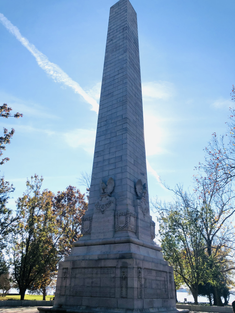Historic Jamestowne - John Smith & Pocahontas
- Mandy-Gentry

- Dec 2, 2020
- 2 min read
The third tier of the historic triangle in this part of Virginia was a visit to Historic Jamestowne.
Founded in 1607, Jamestowne (originally known as James Fort) is the location of the first permanent English settlement in North America. I'm sure most have heard the stories of Jamestowne - John Smith & Pocahontas are some of its more widely recognized citizens. I grew up watching the Pocahontas movie, and although Disney really put a Hollywood spin on things, there is still a wonder left behind by the story. We were thrilled to get the opportunity to be in the exact spot where so much history was born.
Visit the official website HERE!
James Fort is located on a little island on the James River and is connected to the mainland by a narrow isthmus. It is very beautiful, but surrounded by marshes and dense forests. (The walkway from the visitor's center/tickets to the fort site goes down a long walkway over boggy marsh land) It was very obvious that surviving here was no doubt brutal for the first settlers. The artifacts on display and reconstructions exemplified the primitive nature of their dwellings. On top of these challenges, the first settlers were attacked by Powhatan Indians within days of landing.
There is a reconstruction of the first church built at James Fort, based on findings of historians. John Smith said it was “a homely thing like a barn set on crachetts, covered with rafts, sedge and earth.” It was at the front of this church where Pocahontas married John Rolfe (between the wood railings in the picture below.) Crosses throughout the site mark graves found by archeologists.
In 1617, Governor Samuel Argell had citizens build a new church “50 foot long and twenty foot broad.” This timber framed church was built on a one-foot-wide foundation of cobblestones and capped with a wall one brick thick. The First Assembly (the first representative governing body to meet in the Americas) was held in this church in 1619. Some of the original foundations can be seen through glass on the floor of the present building. In 1639 more brick was added to the church and a church tower was later added also.
This church is one of the oldest surviving building remnants built by Europeans in the original thirteen colonies.
There were archeologists at work on an active dig near the church, which was really neat to see in progress. In one of the James Fort water wells discovered by archeologists, it was determined after its usefulness as a water source came to an end it was then used as a "town trash can." Many well preserved artifacts were retrieved from the well, as well as horse, dog and human bones.
Standing near the water is a statue to honor John Smith. Captain John Smith was vital to the survival of Jamestown in its early years. Designed by William Cooper, it was placed along the Jamestown shore in 1908 and is said to watch over the rediscovered footprints of James Fort.





























































































Comments